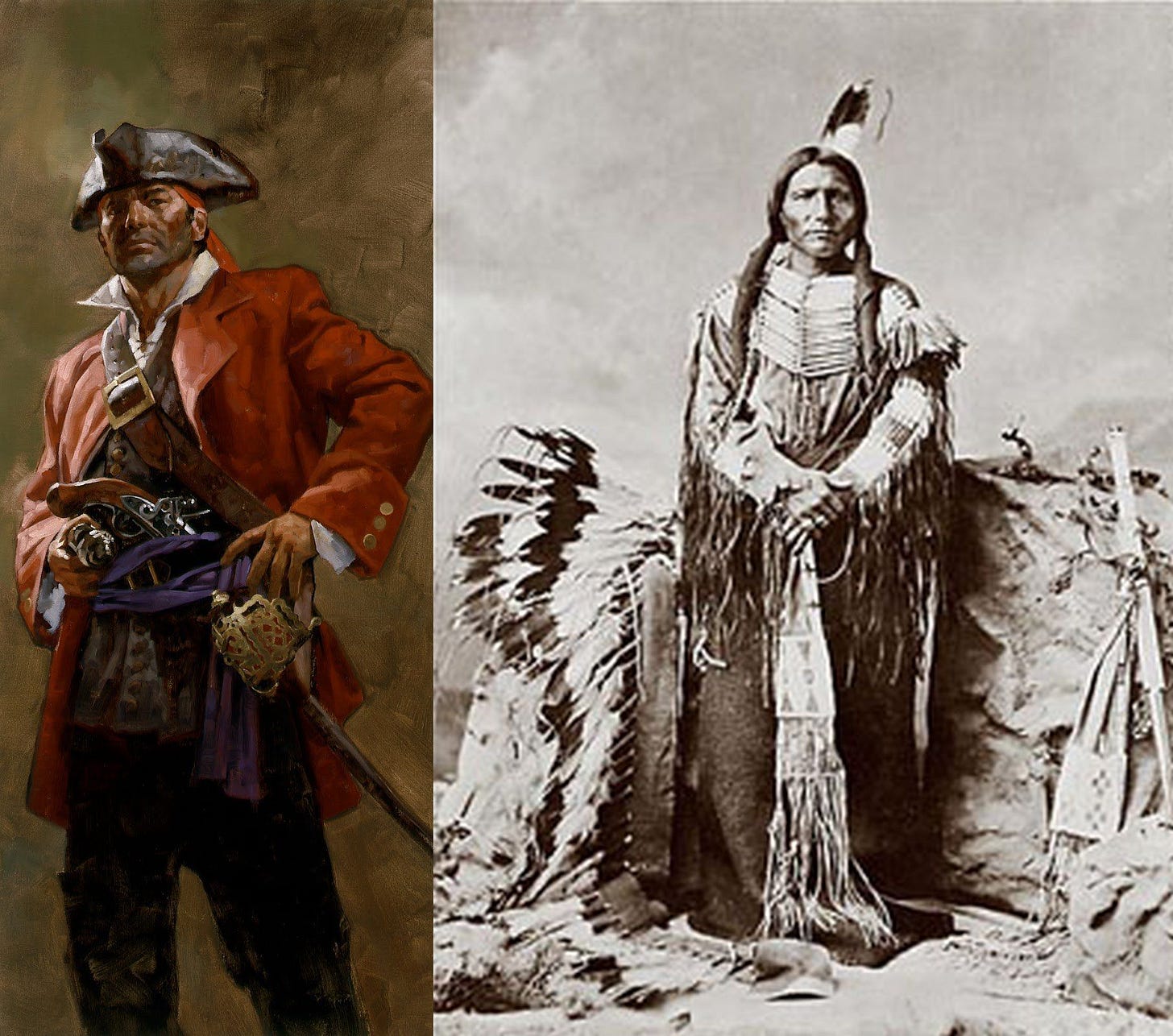Note: By “Indians” I don’t mean East Indians from the land of a billion people, the Taj Mahal, and curry powder; I’m referring to “Native Americans.” I find the term “Native American” to be a rather stilted and overly-formal nomenclature; and full disclosure: A certain percentage of Indian blood courses through my own veins, specifically Wiyot, Karok, Yurok and, yes (so predictably), Cherokee, although I am mainly European-American, especially Irish, Swiss, Portuguese, and English.
So, although calling the first nations of the American continent "Indians" is based on the erroneous notion of Chris "Knucklehead" Columbus that he was in the Indies, I still prefer the designation "Indian" over "Native American" — after all, "Cowboys and Native Americans" just doesn't have the same cachet.I just finished reading The Republic of Pirates by Colin Woodard. Midway through it, I was struck by the similarities between how the Pirates were viewed by themselves and others, and how Indians of past centuries were viewed and what their self-image was.
Brutal. Savage. Unpredictable. Unfair. Both parties under discussion were commonly viewed as exhibiting those traits and behaviors.
I’m not about to say that all Pirates or all Indians were always the opposite of those things. That, in fact, can’t be said of any ethnic or national group, or any grouping of any stripe. In every stratum of society — from accountants to zookeepers, from atheists to Zen Buddhists, from Americans to Zimbabweans, or in just about any other subgroup of humans you can name — you will find specimens who are among the best people on earth as well as examples of people who are among the worst.
What I am saying is that Pirates and Indians often got (and get) a bad rap. We should ask ourselves why the Pirates followed the black flag, and why the Indians sometimes attacked European-American settlements. Were they provoked? Sometimes not, perhaps, but most of the time they were.
Many sailors during the “Golden Age of Piracy” (17th and 18th centuries) were pressed into service by the Navies of their countries, especially England, where they were treated very harshly, often being fed food that was lacking in both quantity and quality, and sometimes were not given their wages for years at a time, if at all (and, when they were paid, it didn’t amount to much). Those who served on merchant vessels didn’t typically fare much better.
It is related in the above-mentioned book that Pirates, on boarding a vessel to plunder it, would sometimes tell the crew, “We are Robin Hood’s men.” What they meant by that was explained by pirate captain Sam Bellemy (shown on the left in the opening image, along with Crazy Horse), who in that book is quoted as telling the captain of a ship they took:
“Damn ye, you are a sneaking puppy, and so are all those who will submit to be governed by laws which rich men have made for their own security, for the cowardly whelps have not the courage otherwise to defend what they get by their knavery. Damn them as a pack of crafty rascals. And you [captains and seamen], who serve them, as a parcel of hen-hearted numbskulls! They vilify us, the scoundrels do, when there is only this difference [between us]: they rob the poor under the cover of law … and we plunder the rich under the cover of our own courage. … There is no arguing with such sniveling puppies who allow superiors to kick them about the deck with pleasure, and who pin their faith upon a pimp of a Parson, a squab who neither practices nor believes what he tells the chuckle-headed fools he preaches to.”And consider this: Captives of both Pirates and Indians often preferred to stay with them rather than return to their previous employer (in the case of those who were captured by Pirates) or to European-American society (in the case of Indian captives). Those taken captive by Pirates — who were much more democratic in how they handled their affairs and dealings with one another, and who shared the booty they accumulated much more equitably — on many occasions quickly accepted their new situation, oftentimes even volunteering to join the Pirates at the first opportunity that presented itself to do so.
As to European-Americans taken captive by Indians, they seldom wanted to return to their old way of life once they had gotten a taste of the native way of living. After experiencing the relative freedom and equality that prevailed among the Indians, a minority of the men and even fewer of the women chose to return to the European-American communities they had come from.
Had you been a sailor in Europe in the 1600s and 1700s, you may very well have been at least open to the idea of casting your lot with a gang of pirates (if not downright champing at the proverbial bit to do so); Similarly, had you been an Indian in America in the 1700s and 1800s (and even later, in some cases), you may have been more than willing to defend yourself, your family, your tribe, and your heritage against interlopers, invaders, raiders, and treaty-breakers — After all, in most cases, it was the European-Americans who initiated and provoked the hostilities.
As the inhumane Navies and greedy merchants to some extent brought piracy upon themselves by means of how they treated their sailors, the arrogant (“manifest destiny”) and racist (“the only good Indian is a dead Indian”) European-Americans also sometimes brought the ire of the Indians upon themselves as a result of how they viewed and mistreated the first nations.
The Indians’ struggle to avoid being marginalized or even eradicated by European-American culture and hegemony may be viewed as a “Red Lives Matter” movement.





